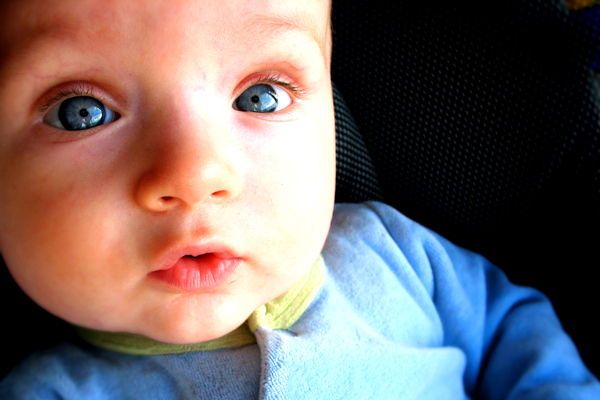5 Incredible Baby Skills

Babies may seem like pathetic (but cute!) human beings, and for the most part, they are. But despite appearances (the fact that they don't know anything at all, can barely focus their eyes and can't even support their own heads), they've got a few impressive tricks up their sleeves.
The following are five surprising things that newborn babies can do better than anyone else. Many are matters of life or death; others simply result from infants' fresh, unadulterated perspectives on the world they've recently arrived in.
Aquatic instinct
Newborn babies sport an assortment of automatic reflexes that they lose later in development, as their brains gradually take the reins in matters of survival. One is the "diving reflex," also known as the bradycardic response; also exhibited by seals and other aquatic animals, the instinct may be a vestige of our ancient marine origins.
It works like this: Infants up to 6 months old whose heads are submerged in water will naturally hold their breath. At the same time, their heart rates slow, helping them to conserve oxygen, and blood circulates primarily between their most vital organs, the heart and brain. The survival response keeps accidentally submerged babies alive much longer than adults would survive underwater.
Rapid learning
Babies gain knowledge at a staggering rate. Almost every experience they have is made permanent by the construction of a new synapse, or connection between brain cells called neurons. By the time a baby turns 3 years old, his or her brain has formed about 1,000 trillion connections, or twice as many as adults have. Beginning around age 11, children's densely connected brains rid themselves of superfluous connections in a process calling "pruning."
Get the world’s most fascinating discoveries delivered straight to your inbox.
Quantum intuition
Bear with us for a quick physics lesson: Quantum mechanics, the bizarre set of rules that govern the behavior of elementary particles, is notoriously confounding. It says a particle (such as an electron or photon) is neither here nor there, but both places at once and everywhere in between, like a cloud rather than a ping-pong ball. Only on the scale of large groups of particles does the fuzziness disappear, making human-scale reality appear concrete and objects' locations seem well-defined. And there's the rub: Our experience of human-scale reality prevents us from comprehending quantum mechanics, and even Albert Einstein couldn't intuitively grasp it.
Newborn babies, on the other hand, aren't accustomed to reality at any scale, and they are thus the only people alive who intuitively understand quantum mechanics, says Seth Lloyd, an expert on quantum computing at the Massachusetts Institute of Technology. Up until the age of 3 months or so, babies lack a sense of "object permanence," or the understanding that an object can be in only one place at one time. Before that time, experiments and games such as "Peekaboo" demonstrate that infants think a hidden object could be absolutely anywhere — a startling demonstration of their intuition for quantum mechanics. [The Mysterious Physics of 7 Everyday Things]
Rhythm
Whether they'll grow up to be star ballroom dancers or to have two left feet, all babies are born with an innate sense of rhythm. This was demonstrated by a 2009 study in which a team of European researchers played a drum rhythm to sleeping 2- and 3-day-olds. The sequence occasionally skipped a beat, in some cases leaving the rhythm undisturbed and at other times making the rhythm stumble. When the latter happened, electrodes glued to the babies' scalps revealed that they exhibited a key brain response indicating their expectations had been contradicted (and thus that they acutely sensed the rhythm). [Why Do We Love Music?]
It could be that a mother's heartbeat gets babies' rhythms on track while they're in the womb, or that their rhythm is instinctual. Regardless of the trigger, scientists think the sense may help babies learn and identify the cadence of their parent's speech, as well as that of their native language itself.
Being cute
No, really. The aforementioned traits aside, babies are so pathetic, needy and (at times) mind-numbingly boring that they would likely suffer neglect if they weren't so darn cute. Fortunately, most babies have got cuteness down pat. In research published last year, a team of Chinese and Canadian psychologists found that both men and women rate infants as cuter than toddlers, who in turn were rated higher than young children. Cuteness drops off considerably around the age of 4 and a half.
That's when kids' facial structure really takes a turn for the less adorable, according to the researchers. Before that time, they have exactly the features that we as a species have evolved to find endearing, including a protruding forehead, large head, round face, big eyes and a small nose or mouth. These cues override our natural aversion to smelly diapers. Cuteness really is a matter of life or death: Other studies have found that infants who have tiny eyes, flat foreheads and square faces are less likely to receive attention.
This story was provided by Life's Little Mysteries, a sister site to LiveScience. Follow Natalie Wolchover on Twitter @nattyover. Follow Life's Little Mysteries on Twitter @llmysteries, then join us on Facebook & Google+.
Natalie Wolchover was a staff writer for Live Science from 2010 to 2012 and is currently a senior physics writer and editor for Quanta Magazine. She holds a bachelor's degree in physics from Tufts University and has studied physics at the University of California, Berkeley. Along with the staff of Quanta, Wolchover won the 2022 Pulitzer Prize for explanatory writing for her work on the building of the James Webb Space Telescope. Her work has also appeared in the The Best American Science and Nature Writing and The Best Writing on Mathematics, Nature, The New Yorker and Popular Science. She was the 2016 winner of the Evert Clark/Seth Payne Award, an annual prize for young science journalists, as well as the winner of the 2017 Science Communication Award for the American Institute of Physics.



